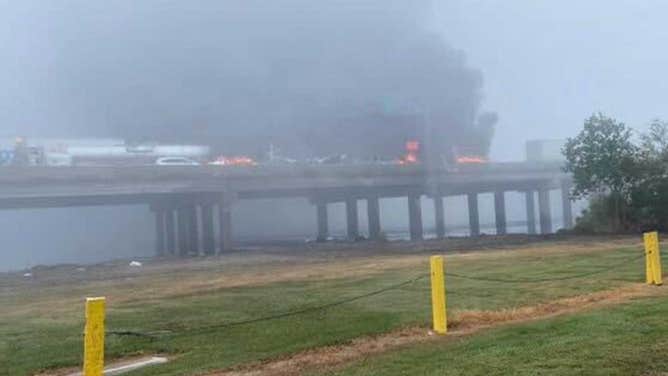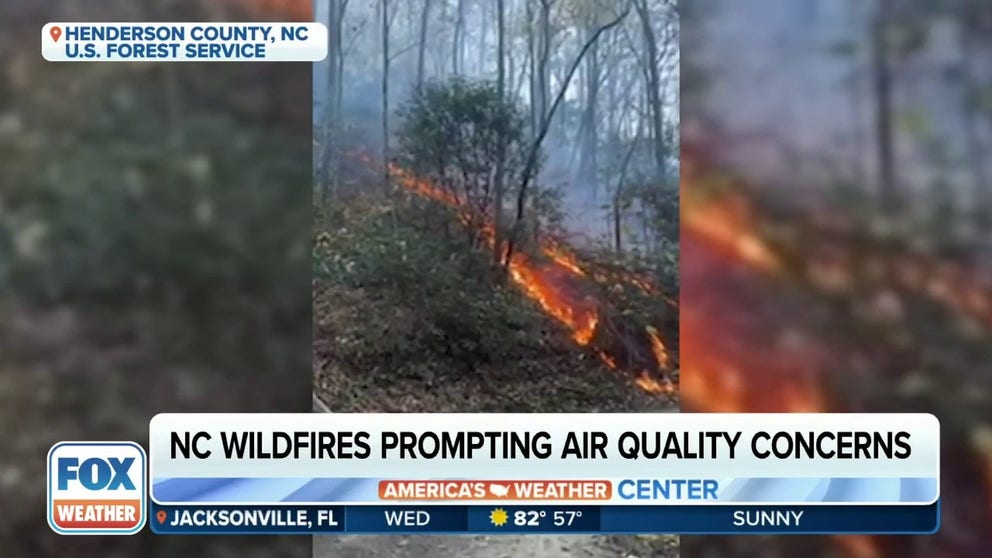Multiple wildfires fueled by drought rage from Texas to North Carolina
Fall wildfire season is off to a raging start, with ongoing drought helping fuel hundreds of fires burning from Texas to North Carolina, leaving two firefighters injured and a Kentucky county inside a state of emergency.
North Carolina wildfires sending smoke throughout region
Drought conditions and falling leaves are fueling wildfire growth in North Carolina. Hundreds of firefighters are battling several large wildfires in western parts of the state.
Fall wildfire season is off to a raging start, with ongoing drought helping fuel hundreds of fires burning from Texas to North Carolina, leaving two firefighters injured and a Kentucky county inside a state of emergency.
According to the data from NASA satellites, there are dozens of fires of more than 100 acres in size burning in Texas, across the Southeast and in the mid-Atlantic regions, while more than 400 fires greater than 100 acres in size are burning across the U.S., according to the FOX Forecast Center.
Fires in Louisiana, Tennessee, North Carolina, Kentucky and Virginia are reducing air quality across the eastern U.S. Smoke particles in the air are prompting local health officials to issue air quality action days or red and orange health alerts.
7 FACTS THAT EXPLAIN HOW AIR QUALITY IS MEASURED

Scenes from fires in Georgia, North Carolina and Virginia. (Images courtesy: state forestry departments)
Where wildfires are burning across the U.S.
The largest fire in western North Carolina, the Collett Fire, is burning uncontrolled and has consumed nearly 3,000 acres in a remote forested area of the Nantahala Mountains. In recent days the smoke has reduced air quality in Andrews, North Carolina, to unhealthy levels on the Air Quality Index.
THE AIR QUALITY INDEX EXPLAINED

(FOX Weather)
Collett Fire Operations Chief Chad Cook said crews are battling the fire in unfavorable weather conditions, including a strong inversion that happens nightly and traps smoke near the ground.
"Down in the valley floor here, colder air gets pushed down and a layer of warmer air gets trapped between two layers of cold air," Cook explains. "So actually down here in the valley floor last night, the temperatures this morning were 34 degrees; up on the fire they were 58 degrees."
Cook said with low humidity and warm temperatures, conditions are primed for the fire to spread.
In Henderson County, the Poplar Fire has already destroyed several homes and continues to threaten dozens of other homes after burning more than 430 acres. Containment remains at 15%.
Richard Cockerham, with the North Carolina Forest Service, told FOX Weather the Poplar Fire is no longer growing and residents who voluntarily evacuated have returned home.
Part of what makes the firefight more difficult is fall when the leaves are dropping, and also how many people live within forested areas. North Carolina ranks fourth in the U.S. for the greatest number of homes within a wildland-urban interface, or where homes meet and intermingle with woodland, according to the U.S. Fire Administration.
"The season is fall," Cockerham said. "We have a lot of deciduous forests here, primarily a lot of deciduous on this particular fire. So we have leaf drop continuing, and so what that entails is new fuel to burn daily until all those leaves are down."
Burn bans are in place across western North Carolina as drought conditions could rapidly turn a spark into a wildfire.

(FOX Weather)
2 firefighters injured in Kentucky blaze amid state of emergency
More than 60 fires are burning in Kentucky, including in Harlan County, where a burn ban and local state of emergency are in place. Crews from Oregon and Idaho are being sent to assist the Kentucky Division of Forestry after fires kept expanding.
Harlan County Executive Judge Dan Mosley said six different wildfires started over the course of three days.
"These fires have resulted in firefighters across the county being in the line of duty around the clock for the last 72 hours," Mosley said in a Facebook post. "We have already seen two firefighters sustain non-life threatening injuries while attempting to protect life and property."
Multiple fires are burning near Knoxville and along the Tennessee-Georgia line. And the Georgia Forestry Commission reported at least five fires driven by drought conditions are being fought in North Georgia.
In Virginia, Gov. Glenn Youngkin declared a state of emergency to help firefighters after two wildfires broke containment lines over the weekend.
The Quaker Run Fire burning near the eastern side of Shenandoah National Park has created poor air quality, according to the AQI forecast. The Quaker Run Fire has grown to 2,800 acres as firefighters work to stop the blaze from spreading west. Residents in Madison County are being told to closely watch for evacuation notices.
Air quality improved on Wednesday in Madison and Charlottesville, where it is forecast to reach moderate levels. Air quality will deteriorate in Strasburg throughout Wednesday reaching potentially unhealthy levels by nighttime.
These stunning images from Peter Forister show the scene ongoing in Shenandoah's National Park.
Firefighters have been battling hundreds of fires in Louisiana since the summer during extreme heat and drought conditions. Fires in southern Louisiana have resulted in super fog on highways, creating near-zero visibility and causing crashes, including a deadly October pileup that involved more than 100 vehicles.

Scenes from a deadly crash on I-55 in Louisiana caused by reduced visibility from super fog. (Image: Lance Scott)
Persistent drought fuels fall wildfires
About 37% of the continental U.S. remains under some form of drought, according to the U.S. Drought Monitor. That is up from 27% three months ago.
South set to get needed rain through Sunday
The FOX Forecast Center is tracking rounds of rain moving up from the Gulf of Mexico into Texas and across the South later this week. The rain will be beneficial for the drought-stricken region.
For the states experiencing rapidly spreading wildfires, drought conditions range from moderate to exceptional – the most extreme on the Drought Monitor's scale.

(FOX Weather)
More than 90% of North Carolina is experiencing drought conditions, with severe drought in the southwestern corner of the state. East Texas, Louisiana and southern Mississippi are facing extreme and exceptional drought.
The FOX Forecast Center is tracking rounds of rain moving into the South later this week which could help improve drought conditions. Several inches of rain are forecast from Thursday through Sunday for areas including Houston and Little Rock.
The coming winter months could help improve drought conditions. With El Niño, forecasters with NOAA predict high chances of above-average precipitation this winter along the Gulf Coast and Southeast.





